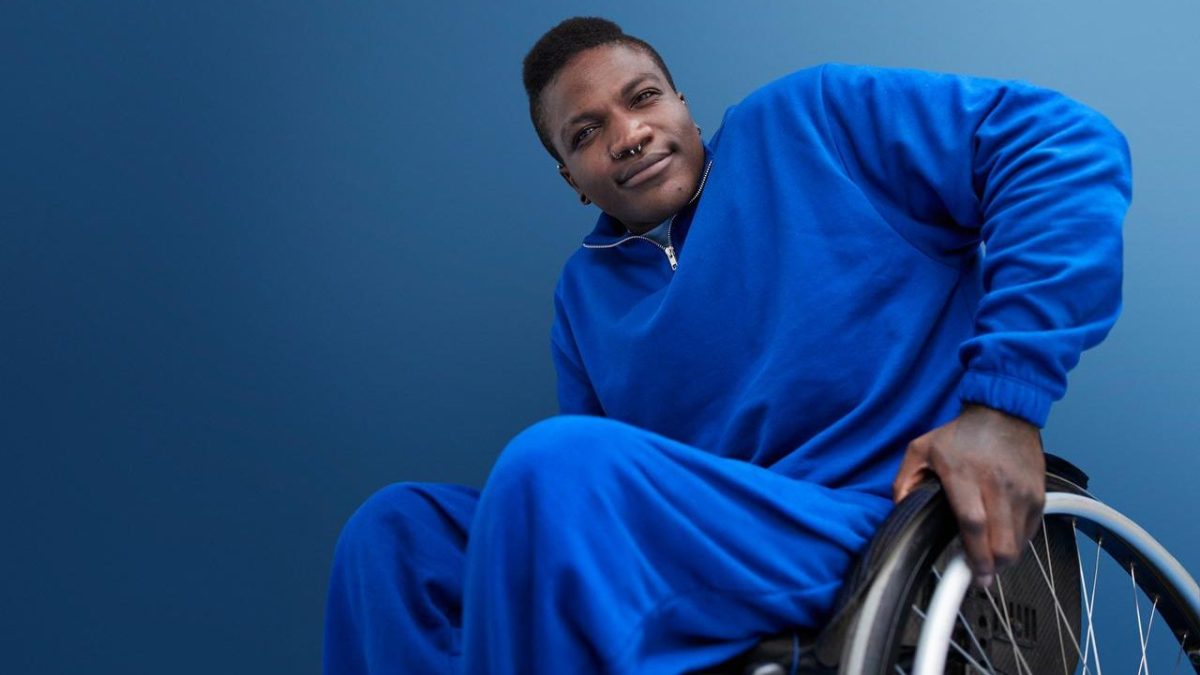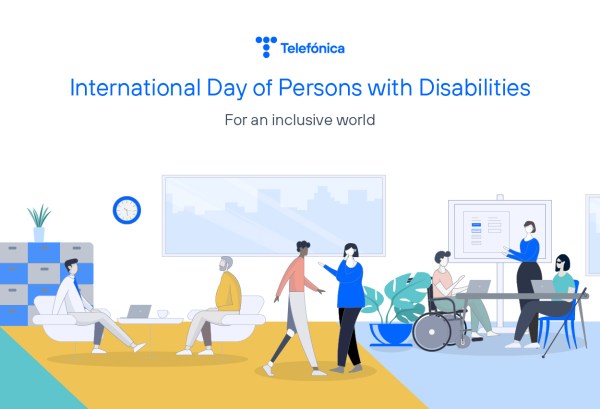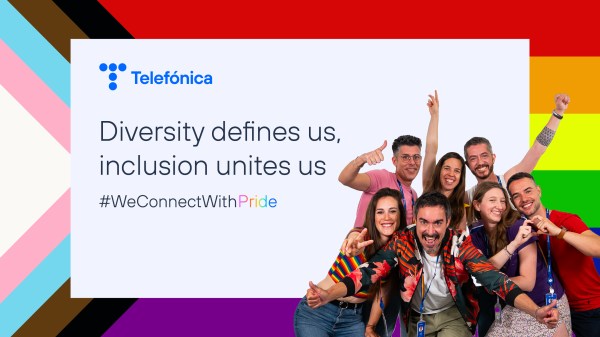This article dives into three reflections that trace the narrative of inclusion at Telefónica. From the first chapter, where I highlight the steady increase in the number of employees with disabilities, to the second, which addresses how to appropriately refer to these people. Finally, we explore the third chapter, where I emphasise the urgency of true inclusion at all levels of the business.
Each chapter, each reflection is a step in our search for understanding and commitment. From the analysis of the reality of work to the importance of conscious language. Join me on this journey, where every word is a pillar in building a work environment that celebrates diversity, connecting lives and transforming the company from the ground up.
My unwavering pride in belonging to Telefónica
I have been walking hand in hand with Telefónica for more than 23 years, and as the days go by, my pride of belonging grows more and more. Today, especially on 3 December, I would like to share one of the main reasons why I feel such a strong sense of pride in belonging to this company.
December 3rd marks the International Day of Persons with Disabilities, a date of great importance for Telefónica, where we are pleased to highlight our strong commitment to equal opportunities. This commitment is perfectly aligned with our core mission of “humanising our world by connecting people’s lives”.
In 2023, we celebrated a significant achievement by increasing the number of employees with disabilities by more than 587 compared to the end of 2022, when we had 1,482 people. So far this year, we have experienced a 40% increase in the number of people with disabilities in our workforce compared to 2022.
Furthermore, we have set an ambitious goal: to double this number by 2024, exceeding 2,700 people with disabilities in our workforce. This growth not only demonstrates a tangible commitment to diversity, but also represents a firm step towards building an inclusive work environment.
At Telefónica, we direct our efforts towards equal opportunities, placing significant emphasis on promoting universal accessibility. We focus on removing obstacles and barriers in both physical and digital environments, ensuring that all employees have access to the same opportunities and resources.
The transformative potential of new technologies is becoming a key tool for improving people’s lives in an increasingly connected world. At Telefónica, we integrate accessibility as an essential component in all our products, services, facilities and channels.
With a particular focus on accessibility and barrier removal, we strive to promote the inclusion of people with disabilities, reaffirming our commitment to diversity and equality in all countries where we operate.
Speaking out: How to refer to people with disabilities
I recognise that at one time I advocated the idea of using terms such as “people with different abilities”, with the intention of embracing diversity and recognising that each individual possesses unique abilities and different capacities. Being aware that 13% of the world’s population requires more support and assistance to normalise their inclusion and full participation in all activities of our society.
Over time, I realised that using this concept in a generalised way diverted attention from the real needs of the 13% of global society. It was then that I realised the importance of addressing the specific particularities and challenges faced by these people, rather than grouping them under a label that might not capture their real needs.
And I definitely realised that I was wrong when I heard the words of Pablo Pineda, the first European graduate with Down’s syndrome and ambassador of the Adecco Foundation, with which he has been collaborating since 2010, giving awareness-raising talks to companies to promote inclusion.
Pablo conveyed: “I am not disabled, I have a disability”. He went on to reflect on terms such as “disabled” and “handicapped”. Journalists sometimes ask him about his opinion on these words and which one he prefers to use in his articles and reports. His answer is always the same: “Call me alone, Pablo, thank you”. He expresses it with a touch of humour, aware that disability is what makes him newsworthy, at least so far. He celebrates this fact because he believes that his story can help break down barriers and stereotypes, harnessing the power of the media.
Pablo, a proud Malagueño, carries with him the values instilled by his parents and has learned to love life. He has pushed himself even when it didn’t seem worthwhile. Although he has a disability, he emphasises that to focus on that alone would mean missing out on much of who he is. First and foremost, he is Pablo Pineda.
From that moment on, two things became very clear to me:
- We should only use the word disability when necessary, and always use the person’s own name, which emphasises his or her individuality above all other characteristics.
- We need to use conscious and respectful language that reflects the diversity and dignity of persons with disabilities, always recognising their status as subjects with rights rather than limiting ourselves to labels that can strip them of their identity and uniqueness.
Equity and Inclusion: A visual journey through concepts
There is an urgent need to make progress towards real inclusion of people with disabilities in all areas of society, with a particular focus on the workplace. It is essential that companies of different sizes, whether small, medium, large or self-employed, actively engage in this process, in line with Telefónica’s commitment.
Before expressing my thoughts on this issue, I find it essential to clarify two fundamental points in order to clarify different concepts surrounding this group of people:
Various concepts related to inclusion are often confused. With the help of a visual representation, I intend to clarify these confusions.
The evolution of the perception and participation of persons with disabilities encompasses terms such as exclusion, segregation, integration and inclusion. Historical exclusion has led to marginalisation and denial of rights. Segregation implies physical or social separation based on misperceptions. Integration attempts to incorporate persons with disabilities into previously exclusive settings, but does not always guarantee genuine participation. Inclusion, on the other hand, represents a move towards an equitable society, where not only physical presence but also equal access to opportunities and rights is sought. Inclusion celebrates diversity and contributes to a more enriching and collaborative society.
It is essential to understand the distinction between equality and equity, as they are neither synonyms nor antonyms. The attached visual representation aims to clarify the difference between equality and equity.
When we speak of equality, we refer to a universal legal principle that holds that all people are equal, regardless of race, nationality, gender, sexual preference, age and other characteristics. However, this notion can generate a paradox: a society that seeks “equal” treatment, in the broadest sense, may ironically be an “unequal” population. This is because we might overlook the real inequalities that exist within human diversity. The attached visual representation aims to clarify the difference between equality and equity.
Business Inclusion: Breaking stigmas and creating opportunities
I would like to share with you a fact that you are probably not aware of and that is essential for all of us to gain a better understanding of the reality of employment for people with disabilities: 74% of people with disabilities are unemployed.
In view of this situation, I would like to share my thoughts on the reasons behind it, with the intention that our entire business environment should move towards improving this circumstance, which I believe we must address with greater commitment, as we can do more and better.
The low supply of opportunities and the persistence of negative attitudes are the key elements that explain the low participation of people with disabilities in the labour market. In many cases, companies are reluctant to hire people with disabilities, fearing that they will not be able to perform their duties adequately or that it will be costly. This attitude is based on fears and stereotypes that, by focusing on the disability, prevent recognition of the person’s inherent abilities.
However, it is readily demonstrated that people with disabilities exhibit outstanding levels of job performance, high retention rates and lower rates of absenteeism. Moreover, the cost of accommodations needed to employ workers with disabilities can be minimal, and in some cases, no special provisions are even required.
Most of our medium-sized, small, micro and self-employed companies (large companies are more informed), in other words, our business fabric, are unaware of the important contribution they could (and should) make to closing this gap, as well as the various financial advantages they could obtain: social security contribution rebates, tax benefits, subsidies and public sector contract awards. Beyond these benefits, there is also the social impact of offering a more human and inclusive face in what we call corporate social responsibility.
From my personal experience, I emphasise the value of the feelings and emotions that arise among all co-workers, regardless of their abilities, generating a pride of belonging that would undoubtedly positively affect the day-to-day running of the company.
It is everyone’s responsibility to correct issues such as these, which diminish us as a society. The time has come to overcome the negative and pitiful view of these people, recognising their faults and virtues like any other person. It is time to unlearn what we have learned in order to learn about the unknown.









